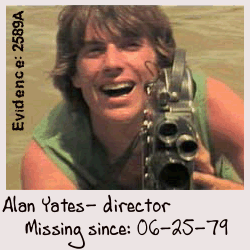Birthplace: Owego, New York, U.S.A.
Residence: New York, New York, U.S.A.
Occupation: Film Director/Producer
Education: M.F.A. NYU Film school
B.A. Columbia (film major)
Hobbies: Filmmaking, surfing, knife collecting,
fencing, anti-war activist |
CREDITS:
- "The Green Inferno" (1979, incomplete)
- "The Last Road to
Hell" (1978, grand jury prize, best documentary New York Critics Association Film Festival)
- "Slaves of South Africa" (1976, Academy of Arts nomination, best documentary, best editing)
- "Vietnam: Horror in the Rice Patties" (1975)
- "The Vermin of Capitalism" (graduate thesis film, NYU, 1972, Awarded film completion grant)
|
| BACKGROUND:
Alan Yates was born and raised in Owego, New York. He obtained his bachelor's degree from Columbia. After taking some film and anthropology classes, Alan soon discovered his purpose in life -- to shoot documentary films. With the documentary form, Alan felt he could show the truth without the manipulation found in commercial cinema.
However, Alan soon succumbed to the same evils that he opposed as an avid film student. His award-winning documentaries which were shocking and horrific in nature, were later rumored to have been fakes. Like the famous documentary
"Nanook of the North," Alan was exposed on CBS's 60 Minutes as a veritable Andy Warhol of docufakes -- setting up situations, paying actors to pretend to be real people, etc. Alan denied all charges.
With his current film "The Green Inferno," Alan sought to refute these rumors of his "setting up" scenes (a faux pas for documentaries) with true footage shot of the only known cannibals in existence, in the wilds of the Amazon. Alan, along with his four companions left with several rolls of film, microphones and two cameras into the wilds of the jungle near the Orinoco River bordering Venezuela and Brazil. He was never seen again and the footage has since been recovered by noted NYU anthropologist, Harold Monroe.
|

